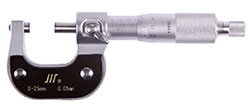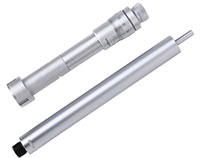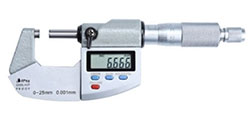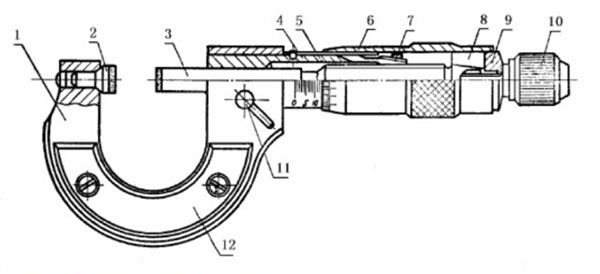What is a Micrometer?
Micrometer is also known as spiral micrometer, centimetre card, it is an instrument that can accurately measure the length and radius of an object, its accuracy is accurate to 0.01mm, more accurate than vernier calipers, it consists of a fixed sleeve and a rotatable screw, when measuring the outer diameter of an object, it will be put into a slot, no matter how the screw rotates when it is not able to move forward, it means that it shows the exact length of the object.
The rotatable knob part of the micrometer has 50 compartments, each of which represents a distance of 0.01mm and needs to be estimated and read by one bit when the object does not reach the specified scale when it is rotated. When marking its length, it is also necessary to write down the number of estimated digits, that is to say, to an accuracy of 0.001mm, which is why it is called a micrometer.
Types of Micrometers
According to their different purposes, micrometers can be divided into:
- Outside Micrometers
An outside micrometer, is a precision measuring instrument used to measure the dimensions of small objects with high accuracy. It is commonly used in fields such as machining, engineering, manufacturing, and quality control.
- Inside Micrometers
Inside micrometers, often referred to as internal micrometers or bore micrometers, are precision measuring instruments designed to measure the inside diameter or internal dimensions of objects such as holes, cylinders, and pipes. They are commonly used in manufacturing, engineering, and quality control to ensure precise and accurate measurements of internal features.
- Depth Micrometers
A depth micrometer is a measuring tool that applies the principle of spiral pair rotation to convert rotary motion into linear motion. Composed of a differential cylinder, fixed sleeve, measuring rod, base, force measuring device, locking device, etc., a depth micrometer is used for measuring dimensions such as depth and steps in mechanical processing.
- Digital Micrometers
Digital micrometers, also known as electronic micrometers or digital calipers, are precision measuring instruments that provide highly accurate measurements with the convenience of digital readouts. They are widely used in various industries, including manufacturing, machining, engineering, and quality control, where precise measurements are essential.
Structure of Micrometers
A variety of micrometer structure is similar, commonly used micrometer by the ruler frame, micrometer head, force measurement devices and brakes, etc., the following figure is the measurement range of 0 ~ 25mm of the outside diameter micrometer. One end of the ruler frame 1 is equipped with a fixed anvil 2, the other end is equipped with a micrometer head. The measuring surfaces of the fixed anvil and the micrometer screw are both encrusted with cemented carbide to improve the service life of the measuring surfaces. The two side surfaces of the ruler frame are covered with adiabatic plates 12, so that when the micrometer is used, the hand is held on the adiabatic plates to prevent the heat of the human body from affecting the measuring accuracy of the micrometer.
Working Principle of Micrometers
Micrometers are based on the principle of helical magnification, i.e. when a screw is rotated in a nut for one week, the screw is moved forward or backward by one pitch in the direction of the axis of rotation. Thus, the minute distance travelled in the direction of the axis can be represented by a reading on the circumference. Screw micrometer precision thread pitch is 0.5mm, movable scale has 50 equal scales, when the movable scale rotates a circle, the micrometer screw can be 0.5mm forward or backward, so rotate each small index, equivalent to the micrometer screw forward or backward which is 0.5/50 = 0.01mm. It can be seen that, the movable scale of each small index represents 0.01mm, so the screw micrometer can be accurately to 0.01mm. As it can also be estimated to read one more, so it is a micrometer.
Method of Using Micrometers
- Before use, check the zero point:
Slowly turn the fine adjustment knob to make the measuring rod and anvil contact until the ratchet makes a sound. At this point, the zero line on the movable ruler (movable sleeve) should be aligned with the reference line (long horizontal line) on the fixed sleeve, otherwise there will be zero error. - Hold the ruler stand with your left hand:
Then turn the coarse adjustment knob with your right hand to make the distance between the measuring rod and the measuring anvil slightly larger than the measured object. Place the measured object in place, and turn the protection knob to clamp the measured object until the ratchet makes a sound. Turn the fixed knob to fix the measuring rod and read.
Notes for Using Micrometers
- When measuring, it is important to stop using the knob when the micrometer screw is approaching the object being measured, and instead use a fine-tuning knob to avoid excessive pressure. This not only ensures accurate measurement results but also protects the spiral micrometer.
- When reading, pay attention to whether the half millimeter mark on the fixed scale has been exposed.
- When reading, there is an estimated digit in the thousandth percentile, which cannot be thrown away casually. Even if the zero point of the fixed scale is aligned with a certain scale line of the movable scale, it should still be read as "0" on the thousandth percentile.
- When the small anvil and micrometer screw are close together, the zero point of the movable scale does not coincide with the zero point of the fixed scale, resulting in a zero error that should be corrected by removing the zero error value from the final length measurement reading.

